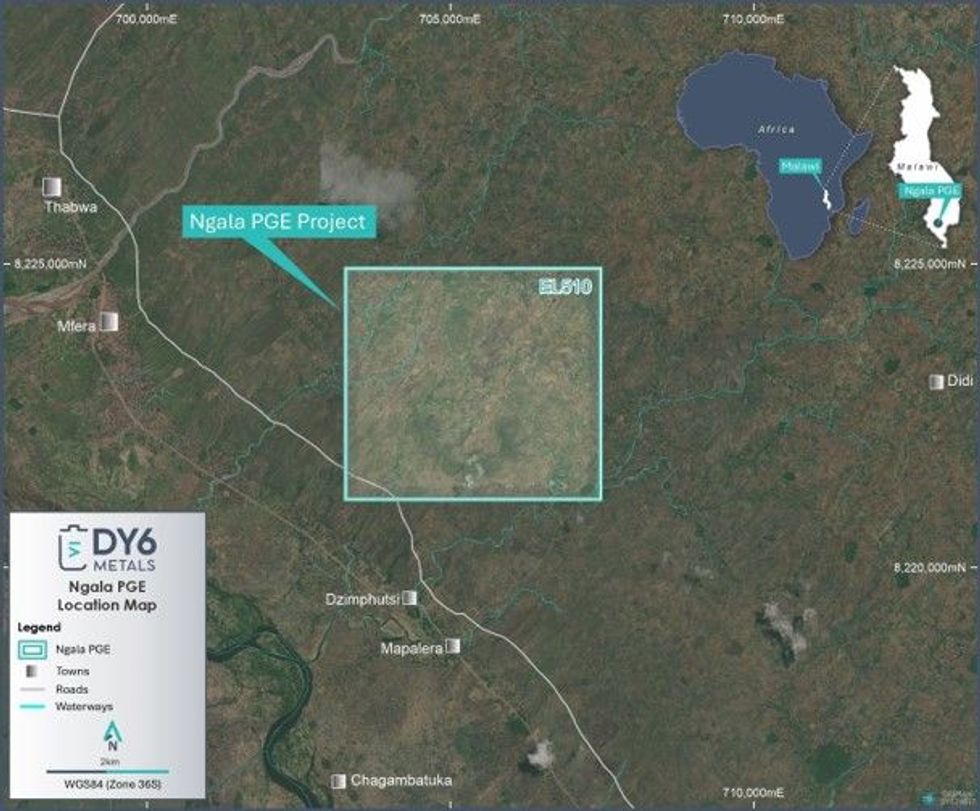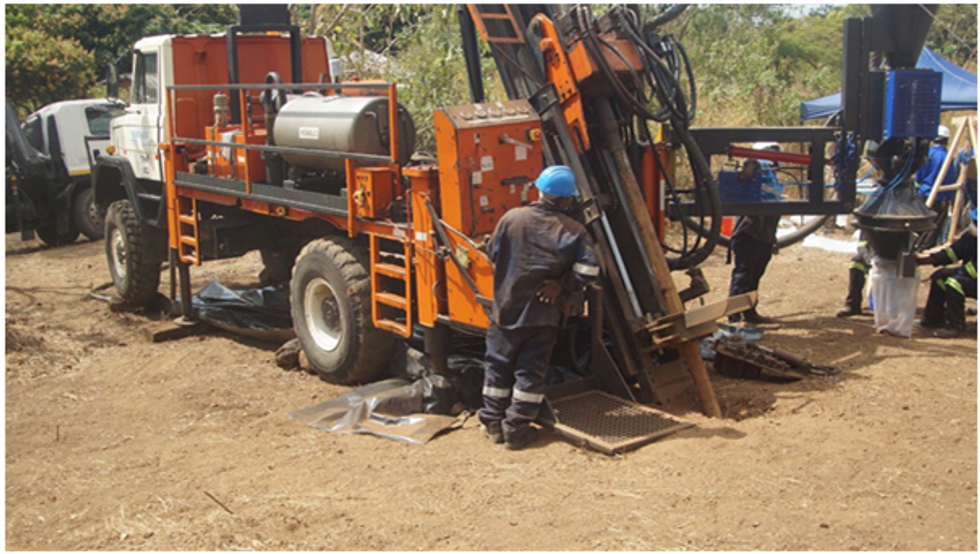
October 02, 2023
Heavy rare earths and niobium explorer DY6 Metals Ltd (ASX: DY6) (“DY6”, “the Company”) is pleased to announce the receipt of initial assay results for the RC drilling program completed at the Machinga Main Northern Anomaly, part of the Company’s flagship Machinga project in southern Malawi (Figure 1).
Highlights:
- High-grade HREE and Nb2O5 results returned from initial 11 holes of 35-hole RC program at Machinga Main Northern Zone
- Multiple +2500ppm total rare earth oxide + yttrium (“TREO”) and significant 1-2 wt% TREO assay values
- Hole MR011 intersected enriched REE mineralisation, returning a standout intercept of:
- 7m @ 1.42% TREO with 0.49% Nb2O5 and 546ppm Dy2O3 + Tb4O7 (3.8% DyTb:TREO) from 65m, plus 1m @ 1.17% TREO, 1.36% Nb2O5 from 119m at end of hole
- Drilling confirms Machinga Main Northern Zone is particularly enriched in valuable heavy rare earths dysprosium (Dy) and terbium (Tb)
- Results returned an average of 28% HREO:TREO and 3.5% DyTb:TREO at a cutoff grade of >2500ppm TREO
- Widespread REE intersections with assays including:
- MR001: 3m @ 5638 ppm TREO, 2102 ppm Nb2O5 from 7m; including 1m @ 1.31% TREO from 8m; and 4m @ 5405 ppm TREO, 2550 ppm NB2O5 from 81m
- MR002: 5m @ 7196 ppm TREO, 2706 ppm Nb2O5 from 44m, including 1m @ 1.65% TREO from 45m; and 3m @ 4615 ppm TREO, 1553 ppm Nb2O5 from 66m, including 1m @ 1.05%TREO from 66m
- MR005: 16m @ 5399 ppm TREO, 2106 ppm Nb2O5 (3.6% DyTb:TREO) from 78m, including 3m @ 1.63% TREO, 0.7% Nb2O5 from 87m
- MR008: 5m @ 5186 ppm TREO, 1698 ppm Nb2O5 from 25m, including 1m @ 1.39% TREO from 26m
- MR009: 5m @ 6175 ppm TREO, 2385 ppm Nb2O5 from 23m
- MR010: 3m @ 6391 ppm TREO, 2334 ppm Nb2O5 from 40m and 10m @ 3919 ppm TREO, 1388 ppm Nb2O5 from 24m
- MR011: 7m @ 1.42% TREO, 4928 ppm Nb2O5 (3.8% DyTb:TREO) from 65m; plus 1m @ 1.17% TREO, 1.36% Nb2O5 from 119m
- Remaining assays from phase one Reverse Circulation (“RC”) and Diamond Drilling (“DD”) program at Machinga to be reported throughout Q4 2023
The results received are from 1m and 3m composite intervals from the initial 11 holes (1320m) drilled as part of DY6’s maiden 35-hole, 3,643m RC drill program at Machinga Main Northern Zone.
Assays returned a series of significant intercepts based on a 2500 ppm total rare earth oxide + yittrium (“TREO”) cut-off grade from the Machinga Main Northern Zone including 7m @ 1.42% TREO with 0.49% Nb2O5 (MR011) and 16m @ 0.54% TREO with 0.21% Nb2O5 (MR005)
The mineralisation at the Machinga alkaline complex contains a higher proportion of valuable dysprosium-terbium (DyTb) with results indicating an average 3.5% DyTb:TREO in samples greater than 2500ppm TREO.
Assays also identified significant critical Nb2O5 potential with grades of 0.28% Nb2O5 at a cutoff grade of 2500 ppm TREO and 0.64% Nb2O5 for samples at TREO grades greater than 1%.
A strongly mineralised hydrothermal breccia system striking NW-SE and dipping shallowly ~35° to the NE has been confirmed by the drilling. Pleasingly, very high-grade zones have been intersected, as well as the suggestion of the mineralised zones thickening at depth (Figure 3). Significant drill intercepts received from the first batch of assays from the drilling program are included in Table 2.
The breccia host was not recognised until the commencement of diamond drilling; with the RC chips then being reviewed, samples will be selected for petrography from both the core and RC drill material.
Cutting and sampling of the diamond drill core, installation of collar beacons on all RC and DD collars and survey of the drill collars along with approximately half the historic Globe Metals and Mining (ASX: GBE) (“GBE”) collars has been completed. Results for the remaining 24 RC holes from Machinga Main Northern Zone are expected to be released progressively during October and the first batch of DD assays (from eight diamond holes drilled for 900m) are expected in the December quarter.
Click here for the full ASX Release
This article includes content from DY6 Metals, licensed for the purpose of publishing on Investing News Australia. This article does not constitute financial product advice. It is your responsibility to perform proper due diligence before acting upon any information provided here. Please refer to our full disclaimer here.
DY6:AU
The Conversation (0)
24 July 2024
Quarterly Activities Report for the Period Ended 30 June 2024
Heavy rare earths and critical metals explorer DY6 Metals Ltd (ASX: DY6) (“DY6”, “the Company”) is pleased to present its quarterly activities report for the June 2024 quarter.
Tundulu (REE)
- Historical high-grade drill intercepts reported at Tundulu including1:
- 101m @ 1.02% TREO, 3.6% P2O5 from surface (TU030)
- 109m @ 1.06% TREO, 3.7% P2O5 from 53m (TU035)
- 100m @ 1.09% TREO, 12.6% P2O5 from 30m (TU042)
- 97m @ 1.35% TREO, 14.4% P2O5 from surface (TU050)
- 91m @ 1.09% TREO, 7.6% P2O5 from 46m (TU026)
- Formal granting of licence area for the Tundulu Project awarded by the Malawian Department of Mines
- Engagement of Met Chem Consulting for initial metallurgical evaluation to review historical testwork work programs and assess the findings from the 2017 metallurgical report
- Trench sampling program (~150kg sample) at historic trench TUTR10 at Nathace Hill completed as part of initial met test work program
Machinga (HREE & Nb)
- Sampling program consisting of a total of 727 rock chips and soil samples completed into recently granted licence area at Machinga. Rock chips returning up to 3.22% TREO and up to 0.75% Nb2O5
- Two anomalies west of the main road of the newly granted licence show a much more continuous character of higher TREO results - highlighting the scale potential of REE mineralisation in this new area of the licence. Assays will assist in refining targets ahead of next phase of drilling.
Ngala Hill (PGE, Cu & Ni)
- Targeted reconnaissance sampling program at Ngala Hill PGE, Cu & Ni Project underway
- 3 key target zones of palladium rich Pd+Pt+Au+Cu mineralisation have been identified from historical trenching and limited drill testing
- DY6 will undertake a rock chip and soil sampling program to follow up on known high grade areas as well as aiming to expand the zone of mineralisation
Click here for the full ASX Release
This article includes content from DY6 Metals, licensed for the purpose of publishing on Investing News Australia. This article does not constitute financial product advice. It is your responsibility to perform proper due diligence before acting upon any information provided here. Please refer to our full disclaimer here.
Keep reading...Show less
02 July 2024
Reconnaissance Sampling Program Commences at Ngala Hill PGE Project to Follow up Historical Targets
DY6 Metals Ltd (ASX: DY6, “DY6” or the “Company”), a strategic metals explorer targeting Heavy Rare Earths (HREE) and Niobium (Nb) in southern Malawi, is pleased to report it is preparing for commencement of a reconnaissance program at the Company’s highly prospective PGE project at Ngala Hill in southern Malawi. The Company has commenced community engagement with local community members at the project site with the purpose to facilitate awareness of the exploration program planned by DY6.
HIGHLIGHTS
- Targeted reconnaissance sampling program commences at DY6’s highly prospective PGE, Cu & Ni project at Ngalla Hill, Southern Malawi
- At Ngala Hill, 3 key target zones of palladium rich Pd+Pt+Au+Cu mineralisation have been identified from historical trenching and limited drill testing
- DY6 will undertake a rock chip and soil sampling program to follow up on known high grade areas as well as aiming to expand the zone of mineralisation
- No significant modern exploration including electromagnetics (EM) to target massive sulphides has been undertaken at Ngala Hill
- Trenching by Placer Dome in 2000 included results of:
- 12m at 3g/t PGE+Au; and
- 70m at 1.12g/t PGE+Au, including 8m at 3.3g/t PGE+Au
- The main mineralised zone has only had limited modern drilling
The Company’s CEO, Mr Lloyd Kaiser said: “Our team in Malawi has actively built strong relationships with local communities across our projects and this early engagement at Ngala Hill is setting the foundation between the Company and the community as we prepare to mobilise the geo team and embark on our first exploration campaign at Ngala.”

Background on the Project
The Ngala Hill ultramafic chonolith is an arcuate-shaped intrusion, with dimensions of approximately 2.4km by 0.7km and was intruded into the underlying Proterozoic Basement Complex gneisses. The Ngala Hill Project is characterised by an intrusive ultramafic suite of pyroxenites and hornblende- pyroxenites that intrude basement gneisses. The pyroxenite facies of the ultramafic complex is prospective for platinum group elements (PGEs), predominantly palladium, and associated copper.
Initial work at Ngala Hill in the late 1960s included geochemical sampling programs undertaken by the British and Malawian Geological Surveys. Phelps Dodge started an exploration program for PGEs on Ngala Hill in 1999 with approximately 600 m of trenching. Metapyroxenite and amphibolite with an PGE- gold-copper nickel association was intersected trenching and yielded 1.41g/t Pt+Pd+Au and 1,430 ppm Cu over a length of 64m.
In 2000, Placer Dome confirmed further anomalies with encouraging results received from several trenches including 12m at 3g/t PGE+Au and 70 m at 1.12g/t PGE+Au, including 8m at 3.3g/t PGE+Au.
Click here for the full ASX Release
This article includes content from DY6 Metals, licensed for the purpose of publishing on Investing News Australia. This article does not constitute financial product advice. It is your responsibility to perform proper due diligence before acting upon any information provided here. Please refer to our full disclaimer here.
Keep reading...Show less
29 June 2023
Heavy Rare Earths & Niobium Explorer DY6 Metals Lists On ASX Following Successful $7M IPO
Heavy rare earths and niobium explorer DY6 Metals Limited (ASX: DY6) (“DY6”, “the Company”) is pleased to announce that its shares will begin trading on the Australian Securities Exchange at 9am Perth today.
- $7 million successfully raised via IPO, including $2.5 million from Hong Kong- based cornerstone investors, Zhenshi Group and Zhung Nam New Material Company
- Funds to be used for exploration on three 100%-owned rare earths and critical metals projects in southern Malawi
- Malawi is an attractive and stable mining jurisdiction with proven potential for hosting major rare earth deposits including Lindian Resources’ world class Kangankunde discovery (40km east of the Company’s Machinga Project)
- RC drilling is already underway at the flagship Machinga project, with diamond drilling scheduled to commence next month
- Drilling aims to follow up high grade 2010 results by Globe Metals and Mining (ASX:GBE)§Machinga is enriched in heavy rare earths (Dysprosium and Terbium) and Niobium
DY6’s listing follows a successful initial public offering (IPO), which raised $7 million. As part of this, the Company attracted a combined $2.5 million from Hong Kong-based strategic investors, Zhensi Group (HK) Heshi Composite Materials Co., Limited and Zhung Nam New Material Company Limited.
The funds raised in the IPO will be used primarily for exploration at the Company’s three 100%-owned rare earths and critical metals projects located in southern Malawi, a stable and attractive African jurisdiction with proven potential for hosting major mineral deposits.
DY6 has recently commenced a 5,000m program of reverse circulation and diamond drilling at the flagship Machinga project, only 40km east of Lindian Resources’ Kangankunde carbonatite discovery, which is widely regarded as the world’s best undeveloped rare earths project.
Machinga is particularly enriched with high-value heavy rare earth elements dysprosium and terbium. The project also holds significant niobium and tantalum potential as well.
Non-executive Chairman Dan Smith said: “DY6 has recently started its maiden drill program at the exciting Machinga project. In addition to being a potential source of the critical heavy rare earth elements Dysprosium and Terbium, Machinga also contains significant Niobium mineralisation.
The Company is seeking to emulate the success of Lindian Resources in proving up a major critical minerals project in southern Malawi. We believe the projects and the team we have assembled provide us with an excellent opportunity.”

Six targets have been identified to date within the Machinga North concession and the Company will be following up on previous high grade intercepts from a previous 2010 campaign undertaken by Globe Metals and Mining (ASX:GBE).
DY6’s other projects in southern Malawi, Salambidwe and Ngala Hill, have also been subject to previous exploration: rock chips from Salambidwe returned high grade values of TREO and Nb while soil samples from Ngala Hill and limited previous drilling by Phelps Dodge returned high grade results of Pd, Pt, Au and Cu.
The Company plans to carry out detailed geophysical and geological sampling programs at Salambidwe to aid in defining targets for a maiden drilling campaign towards the end of the year. RC drilling at Ngala Hill is scheduled for around the same time.
Click here for the full ASX Release
This article includes content from DY6 Metals, licensed for the purpose of publishing on Investing News Australia. This article does not constitute financial product advice. It is your responsibility to perform proper due diligence before acting upon any information provided here. Please refer to our full disclaimer here.
Keep reading...Show less
Latest News
Latest Press Releases
Related News
TOP STOCKS
American Battery4.030.24
Aion Therapeutic0.10-0.01
Cybin Corp2.140.00

